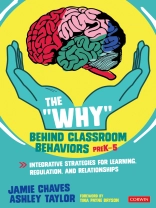Reframing behaviors for competence, confidence, and successful outcomes
With dysregulation and neurodevelopmental diagnoses on the rise, classrooms are more diverse than ever. Despite efforts to support each student’s needs and sensitivities, educators are often left frustrated and unsupported when strategies for managing all kinds of behaviors, from anxiety to acting out, prove ineffective, short-lived, or even detrimental to the students’ and teachers’ happiness and progress.
Through a reflective lens, this book equips teachers and support staff to help all students thrive by identifying and fostering each teacher’s and child’s individual differences and unique strengths. Written in an accessible, conversational style, this book will help educators:
- Build confidence in identifying and addressing behaviors in order to support student growth and brain development
- Learn about an interdisciplinary approach that combines education, occupational therapy, and psychology to better understand and navigate brain-based regulation, relationships, and behaviors in the classroom
- Use relevant research, illustrations, and strategies for reflective and experiential moments
- Discover strategies to facilitate co-regulation, establish positive classroom relationships, address sensory needs, communicate with parents, and practice self-care
This reflective, insightful book provides workable strategies to help all students, as well as those who care for them, feel more competent, confident, and successful.
Inhoudsopgave
Foreword
Preface
Acknowledgments
About the Authors
Chapter 1: Searching for the “Why?”
A Brief Introduction to Interpersonal Neurobiology
Applying a Brain-Based, Relational Lens to the Educational Setting
Chapter 2: Regulation as the Foundation for Learning
What Is “Regulation”?
Reframing the Developmental Expectations of Regulation
Developmental Milestones in Regulation
Promoting Regulation in the Classroom
Chapter 3: The Teacher-Student Dyad and Classroom Community
Understanding the Teacher-Student Dyad and Regulation-Response Cycle
The Power of Mirror Neurons
Harnessing the Positive Power of Mirror Neurons
Rupture and Repair
Facilitating the Continued Development of a Teacher-Student Dyad
Chapter 4: Foundations of Sensory Processing for Regulated Learning
Foundations of Sensory Processing in the Classroom
Teacher-Student Dyad and Sensory Processing
Sensory Systems and Their Impact on Learning
Facilitating Sensory Integration for More Engaged Learning
Chapter 5: Building a Sensory Smart Classroom
Sensory Preferences and Sensory Processing Disorder—What’s the Difference?
Recognizing Different School-Based Sensory Needs
Chapter 6: Developing an Awareness of Individual Differences and Promoting Integration
Recognizing Individual Differences
Moving Toward Integrated Learning
Teaching Students to Search for the Why
Language-Based Learning Disabilities
Nonverbal Learning Challenges
Giftedness and 2E
Other Common Diagnoses That Impact Learning
Common Misconceptions Regarding Learning Disabilities
The Power of Early Intervention
Supporting Integration of Students With Individual Differences
Chapter 7: Handwriting That Promotes Integrated Learning
Developmental and Sensorimotor Facets of Handwriting
Writing as an Integrated Brain Activity
Regulation and Handwriting
Facilitating Improved Handwriting
Chapter 8: Considerations for Specialty Teachers
A Note about Relationships and Regulation in Specialty Classes
Sensorimotor Factors in Specialty Classes
Learning Differences Unique to Specialty Classes
Boosting Regulation and Participation in Specialty Classes
Chapter 9: Redefining Behavior Plans
A Note About Behavior Plans
Structure, Appropriate Boundaries, and Clear Expectations
Natural Versus Punitive Consequences
The Power and Peril of Praise
The Lifespan of a Meltdown and In-The-Moment Strategies
Putting It All Together: A Newly Defined Behavior Plan
Chapter 10: Supporting Students Who Need Additional Help
Understanding Supports Within Your School
Accessing External Supports
Establishing a Teacher-Parent Dyad
Preparing for a Parent Meeting
References
Index
Over de auteur
Dr. Jamie Chaves, OTD, OTR/L, SWC, is a pediatric occupational therapist with over 8 years of experience working with children who have sensory processing differences and learning differences. She received bachelor’s degrees in health science and Psychology from Bradley University, and a doctorate of Occupational Therapy from Washington University School of Medicine in St. Louis. Dr. Chaves is the division leader for the occupational therapy department at The Center for Connection in Pasadena, CA—a multidisciplinary clinic that provides an array of services rooted in the IPNB framework. She recognizes the importance of a play-based, relationship-based approach to therapy that is rooted in regulation. She does contract work with various private schools in Pasadena, CA, particularly delivering teacher in-services and parent education on a variety of topics including promoting positive handwriting, sensory integration strategies in the classroom, how diet and sleep influence learning and regulation, and the impact of screen time on development and learning. Dr. Chaves lives in Pasadena, CA with her husband and 2 young children.












